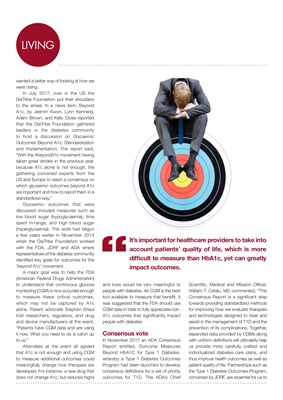
LIVINGLIVING
In July 2017, over in the US the
DiaTribe Foundation put their shoulders
to the wheel. In a news item, Beyond
A1c, by Jeemin Kwon, Lynn Kennedy,
Adam Brown, and Kelly Close reported
that the DiaTribe Foundation gathered
leaders in the diabetes community
to host a discussion on Glycaemic
Outcomes Beyond A1c: Standardization
and Implementation. The report said,
"With the #beyondA1c movement having
taken great strides in the previous year,
because A1c alone is not enough, the
gathering convened experts from the
US and Europe to reach a consensus on
which glycaemic outcomes beyond A1c
are important and how to report them in a
standardized way."
Glycaemic outcomes that were
discussed included measures such as
low blood sugar (hypoglycaemia), time
spent in-range, and high blood sugar
(hyperglycaemia). This work had begun
a few years earlier in November 2014
when the DiaTribe Foundation worked
with the FDA, JDRF and ADA where
representatives of the diabetes community
identified key goals for outcomes for the
'beyond A1c' movement.
A major goal was to help the FDA
(American Federal Drugs Administration)
to understand that continuous glucose
monitoring (CGM) is now accurate enough
to measure these critical outcomes,
which may not be captured by A1c
alone. Patient advocate Stephen Shaul
told researchers, regulators, and drug
and device manufacturers at the event,
"Patients have CGM data and are using
it now. What you need to do is catch up
to us."
Attendees at the event all agreed
that A1c is not enough and using CGM
to measure additional outcomes could
meaningfully change how therapies are
developed. For instance, a new drug that
does not change A1c, but reduces highs
and lows would be very meaningful to
people with diabetes. As CGM is the best
tool available to measure that benefit, it
was suggested that the FDA should use
CGM data in trials to fully appreciate nonA1c outcomes
that significantly impact
people with diabetes.
Consensus vote
In November 2017 an ADA Consensus
Report entitled, Outcome Measures
Beyond HbA1C for Type 1 Diabetes,
whereby a Type 1 Diabetes Outcomes
Program had been launched to develop
consensus definitions for a set of priority
outcomes for T1D. The ADA's Chief
Scientific, Medical and Mission Officer,
William T. Cefalu, MD commented, "This
Consensus Report is a significant step
towards providing standardized methods
for improving how we evaluate therapies
and technologies designed to treat and
assist in the management of T1D and the
prevention of its complications. Together,
expanded data provided by CGMs along
with uniform definitions will ultimately help
us provide more carefully crafted and
individualized diabetes care plans, and
thus improve health outcomes as well as
patient quality of life. Partnerships such as
the Type 1 Diabetes Outcomes Program,
convened by JDRF, are essential for us to
make these important shifts across the
diabetes landscape-from clinical care to
It's important for healthcare providers to take into
account patients' quality of life, which is more
difficult to measure than HbA1c, yet can greatly
impact outcomes."